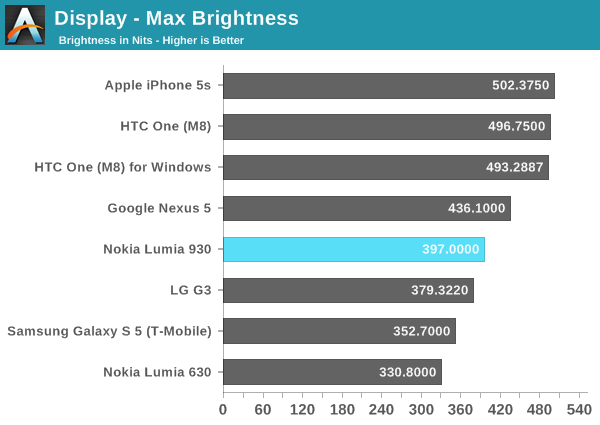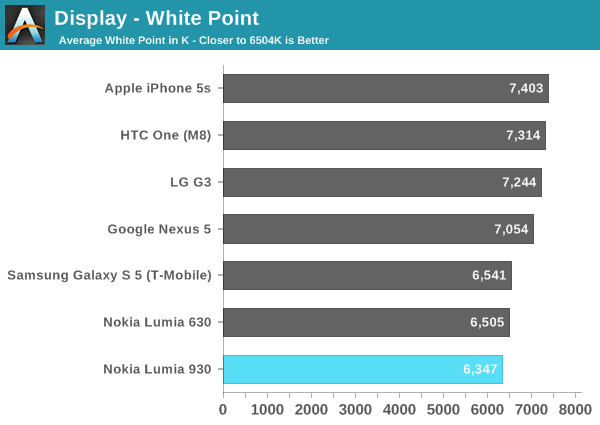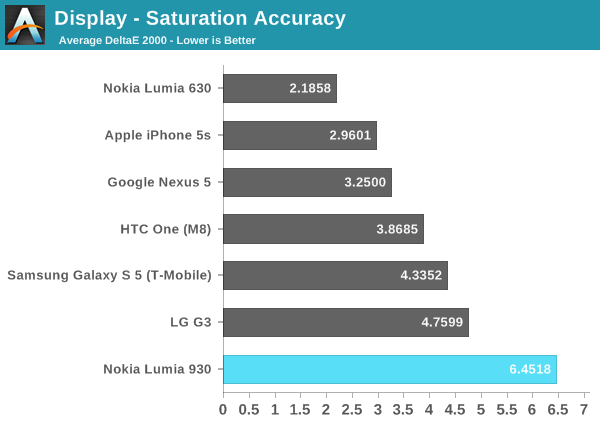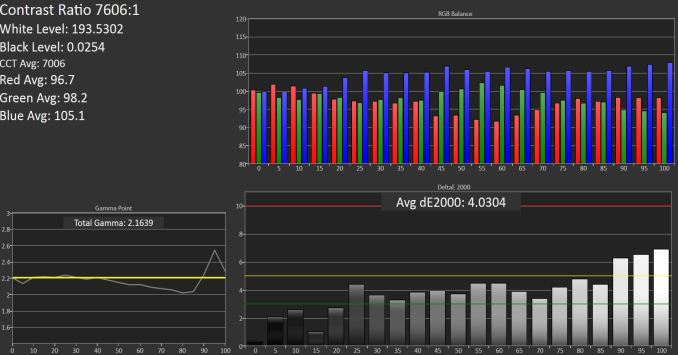Nokia Lumia 930 Review
by Brett Howse on September 8, 2014 3:00 PM EST- Posted in
- Smartphones
- Microsoft
- Nokia
- Mobile
- windows phone
- Lumia
Display
The Lumia 930 packs a 5” 1920x1080 resolution AMOLED display into its chassis. As seems to be the norm for higher resolution AMOLED, the Lumia 930 uses a RGBG Pentile matrix. AMOLED seems to have a lot more issues with color reproduction than most LCD displays, but the recent showing from Samsung with the Galaxy S5 and especially the Galaxy S5 LTE-A model have proven that an accurate AMOLED display can be done. The question is if it was done in this case. As display quality is one thing that can still differentiate one device from another, it is an important point. No part of a smartphone is used more than the display.
The latest Lumia devices with the Nokia “Cyan” firmware offer more customization of display settings than ever before, with fully adjustable brightness, and the ability to adjust color temperature, tint, and saturation. This is a huge step forward, but the hope is that the display can be accurate out of the box as well.
Like the Lumia 630 we recently looked at, the Lumia 930 also supports Nokia’s ClearBlack technology for better outdoor viewing and better black levels due to a reduction in reflections in the display layers. In addition, the device has Corning Gorilla Glass 3, a high brightness mode for outdoor viewing, and a second enhancement for outdoor viewing which Nokia calls “Sunlight readability enhancements” and is a method of performing content-adaptive backlight control (CABC) to adjust the perceived brightness of an image, but rather than doing full-frame CABC which is the common method of doing this, Nokia’s implementation utilizes Assertive Display technology from Apical. Rather than perform the CABC on an entire image, Assertive Display performs the adjustment on a per-pixel level. This can dramatically increase the usability of a display in bright sunlight and it does so without necessarily using more display power. Below is a sample of the Lumia 930 with the feature both on and off.
 Sunlight Readbility Off (upper picture) vs On (lower picture)
Sunlight Readbility Off (upper picture) vs On (lower picture)
This photo is somewhat of a worst case scenario, with a very dark image outside under the full sun. The bottom image is with the Sunlight Readability Mode enabled, and you can see that more of the image is visible.
To test the display accuracy, we turn to Spectralcal’s CalMAN 5 software package with a custom workflow. We utilize the X-Rite i1Pro Spectrophotometer for color accuracy and saturation, and the X-Rite i1Display Pro for contrast ratios. As this is an AMOLED display, we generally ignore the contrast ratios and black levels since the black level of AMOLED is zero, meaning the contrast ratio for all AMOLED displays is infinite.

The maximum brightness is very good for an AMOLED device at around 400 nits. Other 1080p AMOLED displays include the Galaxy S5, which only comes in at 350 nits. The maximum output was achieved in the outdoor viewing mode, with normal brightness levels kept much lower. It is a good result for this type of display and certainly helps with the phone being able to be used outdoors.


Now we can start to see some issues with the Nokia’s implementation of this AMOLED display. White Point is pretty good at 6347. What is missing though is green, which starts to drop off almost immediately after 5 to 10% white level, and then continues to fall right up until 100%. This leads to a grayscale average dE2000 of 9.4777 with the upper scores causing most of the issues. The grayscale almost perfectly follows an inverse of the green levels in the overall image.

Saturation accuracy is also not fantastic, with a dE2000 average of 6.6579. It is not helped either with the grayscale being so far off, which really pulls this score up. But regardless of grayscale, the saturation sweeps show all of the colors are off.

Like the saturation sweeps, the Gretag Macbeth color checker also has a dE2000 average of over 6, which is not great. There is really nothing here to focus in on as being well done. Out of the box, there is clearly no effort put in to calibrate the display at the factory which is a shame because other competitors are putting this effort in.
Adjusted Display
As part of the Nokia firmware updates, we can finally adjust the individual aspects of the display now. Not only can brightness be adjusted on a slider, but color temperature can be adjusted from warm to cool, tint can be adjusted from green to purple, and color saturation can be adjusted from neutral to vivid. This allows us to compensate for the lack of green and try to get the display into a much more accurate mode. While not a true color management system, it is certainly better than no options, or just generic options like “cinema mode” or other such methods of changing the profile of the display.
I performed some adjustments of the tint in order to pull the green values up, and the results were much better. While the white point was increased to 7006, the green values averaged much closer to 100 with this adjustment. Grayscale was still not perfect at 4.03, but it was much better than the initial results of 9.477. Saturation accuracy improved dramatically to 3.6781, and the Gretag Macbeth came all the way down to 3.075 which is right in line with the upper boundary of what you would consider a good display.
The disappointing part is that the display wasn’t dialed in out of the box. Clearly with not much effort, Nokia could have made this display more accurate because a simple tint adjustment brought the numbers way lower.
Overall, the display is a mixed bag. 1080p on a 5” screen means 441 pixels per inch, which is good. The pentile RGBG subpixel layout does not appear to be an issue once the pixels per inch get high enough. Images are very sharp and crisp, and the larger size works well with Windows Phone and gives you access to more tiles on your home screen without having to scroll. I have always like AMOLED on Windows Phone, because the operating system lends itself well to high contrast and good black levels, with AMOLED displays really shining with their true blacks. Unfortunately the color accuracy is quite poor though, and while it can be adjusted, it is too bad that it does not get any sort of calibration at the factory like some of the other flagship devices now.

















115 Comments
View All Comments
ritwik - Tuesday, October 14, 2014 - link
I don't prefer windows phone, I personally feel android platform is goo enough for device. and I am pretty much happy with the way my Honor 6 is performing. It's just an amazing phone. http://goo.gl/4wojuWnuna12 - Tuesday, October 14, 2014 - link
I Lumia 930 with Windows Phone may be best seen, with a beautiful screen, great camera and video performance easily compete with the best Android phones out there. However, I wanted more from the application of the material, and the compatibility of its files is limited.Boogaloo - Wednesday, November 12, 2014 - link
I couldn't help but notice that you included a result of 55 Mbps in your UDP wifi performance table for the Lumia 930. The reviewer that recorded that value (Brett Howse) was called out several times in the comments section of his review for his incompetence for testing wireless performance using a router that only supported 802.11n when benchmarking a device that supports 802.11ac, and even worse placing that result into a graph with phones that WERE benchmarked against an 802.11ac capable router. He then "corrected" the issue by adding a note to the graph (http://images.anandtech.com/graphs/graph8441/67571... that doesn't really fix anything. I don't understand how you can be in a position to write technical articles and reviews without understanding why this is fundamentally wrong.Anyway, apparently his erroneous metrics made it into the database of test results that you pull from despite the fact that it's completely unrepresentative of reality. Please either re-test the performance or just remove the result from your recorded metrics. I know nobody really cares about Windows Phone, but I honestly just expect better from anandtech.
chrisouth - Tuesday, December 2, 2014 - link
I purchased a brand new Nokia Lumia 930 from Singtel Singapore on a contract. The phone would heat up during normal use (making phone calls, checking email, browsing internet, etc..) after two weeks the screen starting showing signs of heat damage.I would have expected a nokia phone to have lasted longer than two weeks!?
On the recommendation from the Singtel retail store I handed my phone into Nokia Singapore (Harbourfront) to be repaired under warranty. Although I would have really expected a replacement handset given that the phone was only 3 weeks old at this point. Apple seem to provide this service all through their warranty period.
After three weeks and I was still waiting for my phone to be repaired. I tried calling the service center over 20 times, yes over 20 times and with no reply. I also tried calling Nokia support and it is so automated that there is no option to talk to a person regarding my service request or just in general (it has now been changed). I also tried re-visiting the service center where I dropped off the phone and it had closed down! With a note to call Nokia AKA the same I tried before which is (was) useless to a human being.
When I did finally got hold of a Nokia rep over virtual chat, they were helpful in answering my questions and providing an update but with no real result. I was told that the service center are waiting on an important part to arrive but without a date when it might arrive.
Well it's now been over six weeks that Nokia Singapore has had my phone. Apparently the parts are still on their way and the delay is due to bulk shipping them... really? from where the moon???!
The Nokia rep was pretty much useless (again). In that he couldn't provide a timeframe or even escalate my call other than add a priority to the repair once the part(s) arrive, whenever that might be.
According to Nokia's own Limited Warranty, "During the warranty period, Manufacturer will, in a reasonable time, remedy the Defect free of charge by either repairing or replacing the defective Product or the defective part of it at its option provided that you have informed Manufacturer of the Defect before the warranty period expires." Anyone with an iodate of common sense would determine that 6 weeks for a phone repair is beyond a "reasonable time".
Surely it must be cheaper to just provide a replacement phone than ship parts over to Singapore??
I purchased this phone from Singtel and its just money wasted as far I'm concerned as what is the point on owning a phone without being able to use it?
Nokia Service in Singapore is absolutely atrocious and non-functioning, compounded with an unannounced service center closure I don't see a future for Nokia here.
Also given my recent experience this will be the last Nokia phone I'll be getting, back to HTC or even Samsung for me.
The whole experience has been utterly frustrating.
Shame on you Nokia.